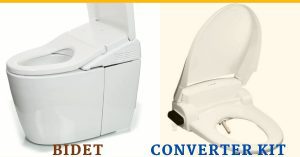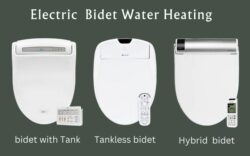Unraveling the Mystery: Do Bidets Really Use Toilet Water?
Have you ever wondered if bidets use toilet water? It’s a common question that many people have when considering installing a bidet in their bathroom.
The idea of using toilet water for cleaning can be off-putting for some, leading to uncertainty and hesitation.
In this article, we will delve into this query and provide you with a clear understanding of how bidets work and what type of water they use.
If you’re curious about the safety of bidets, particularly for women, you can explore this insightful article on Are Bidets Really Safe for Women?. It covers important information that can help address any concerns you may have.
Moreover, understanding the intricacies of bidet usage involves exploring various aspects, including the type of bidet attachments available. If you’re considering purchasing a bidet attachment, it’s crucial to be aware of the factors to consider. Check out Essential Factors to Consider Before Buying a Bidet Bidet Attachment for valuable insights into what to look for when choosing a bidet attachment.
Understanding Where Bidets Get Their Water
Have you ever wondered where bidets get the water they use? It’s a common question, especially when you’re thinking about adding a bidet to your bathroom. Let’s make it simple: bidets can either be the traditional kind, like a separate bathroom fixture, or the modern type that attaches to your existing toilet.
Traditional Bidets:
Imagine a separate thing in your bathroom just for cleaning, like a little sink but for your bottom. These old-school bidets have their own water supply. So, you don’t need to worry about it sharing water with anything else in your bathroom. For more insights into the traditional bidet experience, check out A Brief History of Bidet and Its Evolution Around the World.
Modern Bidet Attachments: Now, think about a bidet that joins forces with your regular toilet. These newer ones also have their own water supply, working independently. That means you get the benefits of a bidet without needing a whole extra thing in your bathroom. To explore the variety of modern bidet attachments available, you can refer to Best Bidet attachments.
Let’s break down how these bidets get their water to wash away any worries you might have.
Understanding Bidet Water Sources
To comprehend whether bidets use toilet water, it’s essential to understand bidet water sources.
Traditional bidets differ from modern bidet attachments. While traditional bidets are standalone fixtures with dedicated water supplies, modern bidet attachments connect to existing toilets.
The Plumbing Behind Bidet Water
When it comes to modern bidets, they’re not tapping into your toilet’s water supply. Bidet seats and attachments are all about connecting to your bathroom’s water lines independently.
It’s like they’ve got their own plumbing party going on, ensuring a separate and clean water source.
The Root of the Problem: Misconceptions and Concerns
Many individuals believe that bidets use toilet water due to their close proximity to the toilet bowl. This misconception stems from a lack of understanding about bidet plumbing systems.
The fear of using potentially contaminated water for personal hygiene purposes is a valid concern that needs to be addressed.
Unveiling the Truth: Bidet Plumbing Systems Explained
Contrary to popular belief, bidets do not utilize toilet water for cleaning purposes. Modern bidets are equipped with separate plumbing systems that ensure the use of fresh, clean water.
These systems are designed to connect directly to the main water supply, providing a continuous flow of water that is free from any toilet-related contamination. For more insights into the design and functionality of bidet plumbing systems, you can refer to Kinds and Key Benefits of Bidet.
The misconception arises from the fact that bidets are often positioned near the toilet bowl for convenience. However, this proximity does not imply a shared water source.
The Solution: Independent Water Supply
To address the concerns regarding the use of toilet water in bidets, it is important to understand the design and functionality of these devices. Bidets are equipped with separate water connections, allowing them to access a fresh water supply that is independent of the toilet.
By connecting the bidet to the main water supply, users can enjoy the benefits of a clean and refreshing cleanse without any worry of contamination. This independent water supply ensures that the bidet remains hygienic and separate from the toilet.
The Advantages of Independent Water Supply
Having an independent water supply for bidets offers several advantages. Firstly, it eliminates the risk of using toilet water for personal hygiene, providing peace of mind and reassurance to users.
Secondly, it ensures a constant flow of clean water, promoting optimal cleanliness and hygiene. Lastly, it allows users to adjust the water temperature and pressure according to their preferences, enhancing the overall bidet experience.
Conclusion: Bidets and Cleanliness Go Hand in Hand
Despite misconceptions, bidets do not use toilet water for cleaning purposes. The proximity of bidets to toilets does not imply a shared water source.
By understanding the design and functionality of bidet plumbing systems, users can confidently embrace the numerous benefits of bidet usage. With an independent water supply, bidets provide a hygienic and refreshing experience, promoting cleanliness and well-being.
FAQs
1. Do bidets use toilet water?
Yes, bidets typically use toilet water. They are designed to connect to the existing water supply of the toilet, allowing them to utilize the same water source. This ensures that bidets have a constant supply of water for cleaning purposes.
2. Is the water used by bidets clean?
Yes, the water used by bidets is clean. It comes directly from the same water supply that feeds into the toilet tank. However, it is important to note that bidets do not reuse toilet water for cleaning. Each use of the bidet involves fresh water from the supply line.
3. Can bidets contaminate the toilet water?
No, bidets are designed in a way that prevents contamination of the toilet water. They have separate water channels and valves that ensure the water used for cleaning does not mix with the toilet water. This helps maintain hygiene and prevents any cross-contamination.
4. How does the bidet water source stay clean?
The bidet water source stays clean due to the presence of backflow prevention mechanisms. These mechanisms prevent any backflow of water from the bidet into the toilet’s water supply. Additionally, regular cleaning and maintenance of the bidet can help ensure the water source remains clean and free from any potential contaminants.
5. Can bidets be installed in any toilet?
Most bidets can be installed in standard toilets. However, it is recommended to check the compatibility of the bidet with your specific toilet model before making a purchase. Some bidets may require additional plumbing or modifications to the existing toilet setup, while others may be specifically designed for certain toilet types.






